The baby's second and third months
• How was made the mapping of the community?
• How became the division of children and pregnant women among the leaders?
• Based on what has been seen and felt what else would you like to share?
• Is there any message, prayer or a biblical quotation which celebrates the gift of life and the actions that we have performed with our next? A suggestion is:
To See
The baby from 2 to 3 months
1. In your community how are fed the babies of this age?
2. Which health problems the babies of this age usually have?
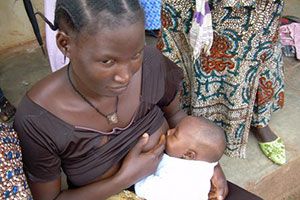
Foto:
Leader, in the talks with the mothers and other family members, explain that the mother’s milk continues to be the sole food that the baby needs. Tell that it is common that the baby of this age does not defecate for one or two days.
The mother who breastfeeds should not smoke, drink alcoholic beverages or other drugs. Medicines should only be used with medical guidance. Some cigarettes, alcoholic beverages and medication substances go to the milk and may harm the baby. Thus, the mother who breastfeeds, needs to be more careful, for her own sake, for her baby’s and also for the other family members’ sake.
When the mother has more milk than her baby can soak, she can donate that milk to a hospital that has the Milk Bank. There this milk will be pasteurised and given to a baby who is in need of it.
Leader, verify if in the hospital of you municipality there is a Milk Bank and encourage the donation. Donating maternal milk is an act of love!
How the baby can learn and grow

Foto:
When the mother or the father smiles to the baby, does the baby respond to it with another smile?
Each baby has his/her own way of communicating with the people. When he/she is hungry, crumps or wants to change the position, he/she can cry, get agitated or retract the legs; when he/she feels well, he/she can smile or agitate the arms and legs with happiness.
A baby that responds to the smile of the mother or the father shows the good relation he/she has with them and how much adults’ attention is important for him/her. What the baby likes and needs most is to stay with the mother or who always takes care of him/her, because of the trust bond which is established between them. If the father always stays with the baby, this bond will also be established.
When the baby is awoken he/she gets calm and happy if the mother or the father is close to him/her. When they work at home, the parents can put the baby close to them to talk or sing to him/her. Thus, he/she gets encouraged to make sounds like: “arg, arg, arg” or “grr, grr, grr”.

Foto:
When the mother or the father moves the face slowly before the child, does he/she follow this movement?
The baby likes to touch and play with the people’s face and the hands. He already puts some effort in driving his/her attention and following with the eyes the movement of the parents.
The baby likes to look, stir and play with his/her small hands that at this stage remain more open. He/she can look and catch things which are put close to his/her hand like rattles and other colourful objects. He/she takes to the mouth everything he/she catches, for the mouth for the baby is a source of pleasure and learning.
Attention: the family needs to watch for not letting tissues or plastics be close to the baby because he/she can get suffocated. Strings and cords close to the cradle or pacifier cords around the baby’s neck are also very dangerous for the baby can hang himself/herself.
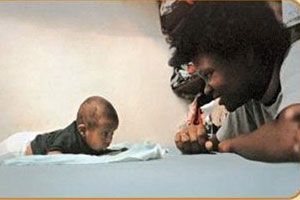
Foto:
When the parents put the baby on his/her tummy, does he/she raise the head and the shoulders supported by his/her arms?
The baby needs to be well at ease to learn to control the movements of his/her body. He/she still needs the help to change the position: to turn to his/her side, to lie on his/her tummy or to lie back. Thus, he/she can see different things around him/her, every time control better the movement of his/her head and increase the arms' strength.
The majority of the babies still sleep a lot. But each baby has his/her own sleeping time; some are sleepier than others.

Foto:
The parents hold the baby in their lap to caress, talk and play, even when the baby is not crying?
The baby likes and needs the tenderness of a lap. He/she likes to be touched, kissed, to hear the parents talking and singing in a low voice to him. The baby should not only go to the lap/ be hold only when he/she cries because then he/she will learn that only crying he/she can have attention from the parents. Babies are smart and learn very fast.
It is important to continue putting the baby to take sun without clothes. This helps to air out the skin and stimulate the benefit of D Vitamin. This vitamin helps to form the bones and strong muscles, preventing the rickets in the baby.
Attention: Small children should not hold alone the babies in their lap because they can harm him/her if they let him/her fall.
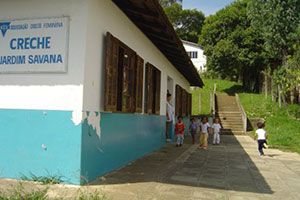
Foto:
When the mother has to work, she may have the need to put the baby in a day care centre. In Brazil, the children from zero to three years old are assisted in day care centres and the children of four and five years old are assisted in a kindergarten, according to Law of Education Policies and Regulations – LDB.
The day care centre, should provide, like the home, a favourable environment for the child development. Thus, the day care centre’s activities should comprise health – food, hygiene and resting aspects – as well as other activities and plastic arts. Besides those, it is also necessary to provide many playing opportunities, for playing is a child’s need. In the day care centre the child lives with other children and adults, taking part of several experiences that increase the child’s learning and autonomy opportunities.

Foto:
You, leader, can instruct the parents to observe if the day care centre has:
• An aerated, clean and space for the children to move in several ways;
• Clean, safe and diverse materials;
• Qualified professionals; and
• Pedagogic proposal that promotes the health and learning of the child.
The day care centre is a right of the child and the family, for it is the first stage of the basic education. In the Children Statue it is ensured the assistance in day care centres and kindergartens to the children. The mayor is obliged to ensure day care centres for the children of his/her municipality.

Foto:
Touching the baby’s body
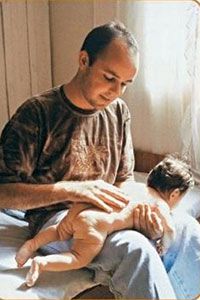
Foto:
A gentle and rhythmic massage in all baby’s body provides him/her well-being, activates the blood circulation and helps him/her to perceive his/her own body. It is also another way to narrow the bond between the baby and his/her parents.
The massage can be made:
• In the tummy, in circular movements;
• In the arms, stretching from the shoulder to the hand;
• In the legs, stretching from the thigh to the foot;
• In the back, up and down, from the neck till the baby’s legs.
It is necessary to observe if the baby is enjoying the massage, for in some moments he/she wants to be let quiet
The massage can be made before the bath or when the mother or father has an available time and is calm to be able to enjoy this moment with the baby. It can be made in the open air provided that the temperature is pleasant and that there is no wind because the baby has to be without clothes.
Upon you I was thrust from the womb; since birth you are my God. Psa 22,11
Hygiene
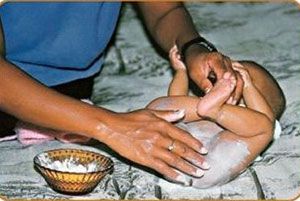
Foto:
The daily bath protects the baby’s skin from galls that can infect and cause other diseases.
In order to prevent galls, the mother can make a home paste of water, corn flour (maizena) or manioc flour (gum) mixed with a little cold water. This paste should be passed on the wiped baby’s buttocks when it is dry after the bath and every change of diapers.
It is important that the parents begin to do the hygiene of the baby’s mouth still before the first tooth appears. This cleaning is made with a clean wet tissue that is passed on the gum, cheeks and tongue of the baby after every breastfeeding. The tissue should be used only for this purpose and should be kept clean.
Vaccines
The children need vaccines to be protected against some diseases. Therefore, leader, it is important that you encourage and instruct the mothers to get their children vaccinated. The vaccines also contribute to the decrease of child’s mortality.
In the 2nd month the baby takes:
A- The first dose of vaccine against Poliomyelitis (Sabin);
B- The first dose of Tetra vaccine, against Meningitis and other infections caused by Hemofilus, Tetanus, Diphtheria or Croup and Whooping Cough
C- The first dose of vaccine against Rotavirus (this virus is one of the causers of diahrrea).
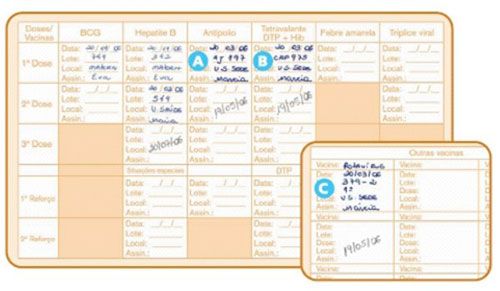
The vaccination schedules may have small differences among the municipalities. It is good that the leader seeks for the health service and gets informed about the schedule adopted.
Scale
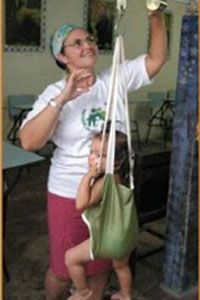
Foto:
The scale is one of the tools used on the Celebration of Life day. With this it is possible to know what is the child’s weight and trace a growth line on the Health Card
On the Celebration of Life day all the accompanied children are weighed. This day should be used for the leader to talk to the parents about their children’s development.
In order to make the weight follow up it is necessary to learn how to use the scale and assess the growth in the Health Card.
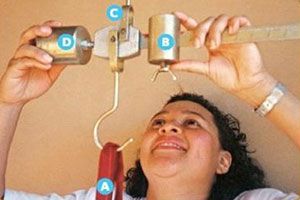
Foto:
At the place chosen for the Life Celebration day, look for a safe place to tie up the scale. It is important to test it in advance to see if it is safe and if it will support the child’s weight.
After that it is necessary to regulate the scale:
• Hook the A support where the child is going to be placed;
• Put the B weight in the zero position;
• Check if the indicator C is very much in the middle. For this to happen, loose the screw of the counterweight D and gently move its position.
After the scale is regulated is that the children can start to be weighed.
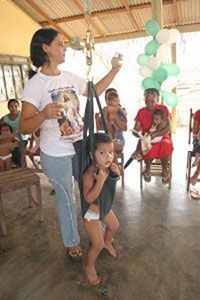
Foto:
Whenever the baby is going to be weighed, it is necessary to take all his clothes for any 100 grams of clothing makes a lot of difference in the assessment of his/her weight. The baby has to be put in the scale gently so he/she does not get scared.
The older children can be weighed with panties or shorts, because they may feel embarrassed to take off their clothes in front of other people and for the older ones the weight of the shorts do not make such a difference.
In cold days, it is not possible to take off all of the baby’s or children’s clothes. Therefore, you should weigh some of the babies' and the children’s clothes usually wore by them and discount those grams from the weight.
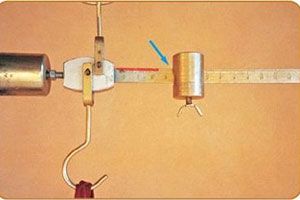
Foto:
It is important to learn to read the weight well. Always read in the position marked by the indicator, in the photo above. The scale of the photo it is marking three and a half kilos.
This weight shall be written down on the page of the Leader’s Notebook which has the name of the child followed. It also should be written down with a dot on the weight graph of the child’s Health Card. This card should always be with the parents.
After weighing three or four children, it is necessary to check if the scale has the indicator set very much in the middle. If it is not, it is necessary to regulate the scale again.
Pneumonia
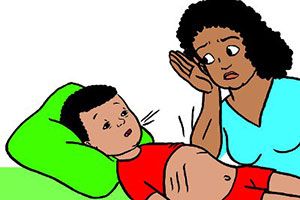 .jpg" alt="" width="300" />
.jpg" alt="" width="300" />
Foto:
Pneumonia is a serious breathing infection. If the child does not receive the correct timely treatment, he/she can die.
Pneumonia is more dangerous in babies:
• younger than 2 months;
• who were born with less than two kilos and a half;
• who are not breastfed;
• who are malnourished;
• who are not updated in the vaccines.
Some environment conditions make the air get polluted and facilitate catching this type of disease. They are the houses in which the sun does not enter, where the air is not renewed, where there is dust and smoke of cigarettes, where the stove is fed with wood or where there are cars or factory pollution or burnt woods.
The habit of smoking near the child increases the chances of him or her having breathing problems such bronchitis, ear inflammation, sinusitis, asthma and pneumonia.
Leader, when the baby shows some sign of breathing infection, you have to instruct the mother to:
• Take the child to the doctor as quick as possible;
• Continue to breastfeed the child;
• Give the medications in the dose, times and for the period recommend by the doctor;
• Go back to the health service on the scheduled date or at any time, if the baby does not show any improvement or gets worse.
If you observe some sign of danger in the children you follow, forward them immediately to the hospital.
The Acute Breathing Infections are one of the main health problems among the children younger than five years old. Recognizing the signs of danger and begin the treatment soon help to reduce the seriousness of the disease and can avoid the death of pneumonia.
Therefore, the recommendation of WHO - World Health Organization – is that the child receives the first dose of the medication still in the health service unit.
Attention: Any medication should only be given to the baby upon the doctor’s prescription.
Signs of danger for the health of children from the second month to five years old
Leader, it is important that the family members know to identify the signs of danger. Instruct them to be watchful and to go to hospital immediately if the baby shows any of those signs:

Home Visit
In those visits it is important to:
Talk about breastfeeding/feeding;
Talk about the vaccines for the age;
Deliver the Love Bond Cards referring to the
“Signs of danger for the health of children from the second month to five years old”.
Answer the questions of the Leaders’ Notebook.
Task suggestion for this qualification stage
Visit the children already registered and give special attention to the indicators of opportunities and achievements.



